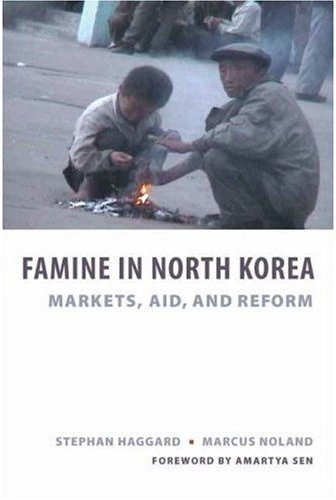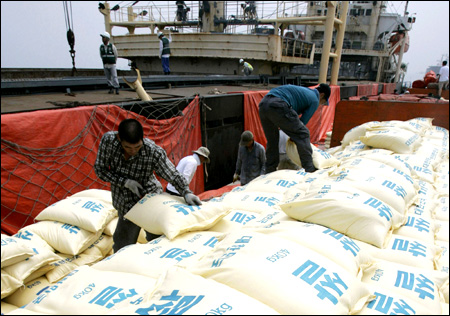Korea Times
Marcus Noland, Stephan Haggard
9/21/2007
Last summer North Korea conducted provocative missile and nuclear tests. Yet only four months later, Pyongyang signed on to a roadmap that included a return of international inspectors, a full declaration of contested nuclear activities, closing down existing facilities and ultimately disabling them.
American negotiator Christopher Hill predicted this last step could take place as early as the end of the year.
What are the North Koreans up to?
The cynical, some would say realistic, view in the United States _ advanced by departed Bush administration hawks such as John Bolton _ is that Kim Jong-il is raising false hopes.
The appearance of cooperation has several tactical advantages. Sanctions and ongoing uncertainty have had substantial economic costs. The February agreement was preceded by secret meetings in Berlin to resolve the Banco Delta Asia issue.
In return, the North Koreans closed their nuclear facilities, but they have not firmly committed to the difficult aspects of the agreement _ providing a full accounting of their programs, disabling their programs, and giving up actual stores of fissile material and weapons.
Cooperation also drives wedges between the U.S., South Korea and China. If North Korea appears to be making concessions, it is easier for South Korea and China to continue diplomatic and financial support.
Next month, President Roh Moo-hyun will travel to Pyongyang for a summit with Kim Jong-il. Expect him to come bearing gifts to cement his legacy as a peacemaker.
Other politicians in the presidential race have also offered extraordinarily ambitious and generous programs of support for the North as well.
Recent studies we have done on North Korea’s changing external economic relations are consistent with some of this cynical picture, but also suggest a sliver of hope for more substantial change.
To understand why, requires a brief tour of the miserable history of North Korea over the last two decades. Following the collapse of the Soviet Union, the North Korean economy went into a steep decline ending in full-blown famine.
By our estimates, as many as one million people _ five percent of the entire population _ perished in the mid-1990s. Out of the human ashes of this tragedy, however, the North Korean economy began to undergo a profound transformation.
As households and work units scrambled for food, they engaged in barter, trade and new economic activities.
The desperation of the famine also saw an upturn in illicit activities, from missile sales to drugs and the counterfeiting of U.S. currency. But trade and investment also started to flow across the Chinese border.
Chinese companies, small-scale traders and North Korean firms pursued business opportunities, from large-scale mining operations to the import of South Korean videos.
The regime was always hesitant about the emergence of the market. In July 2002, the government initiated economic policy changes that decriminalized some private activities. But reforms have taken a zig-zag path, always subject to reversal.
Sanctions and closer scrutiny have limited the country’s arms sales and illicit activities.
With these sources of revenue increasingly foreclosed, North Korea has two alternatives _ open the economy and increase normal commercial activities or cooperate primarily to obtain aid. In terms of internal change, these two options may actually push North Korea in opposite directions.
Consider the aid tack. Given the regime’s concerns about internal stability, aid could provide a lifeline, allowing the regime to sustain a modicum of current consumption while forgoing deeper reforms. Under this option, North Korea trades away its nuclear program for assistance precisely to maintain the political and economic status quo.
Alternatively, North Korea could use the resolution of diplomatic tensions to deepen the economic reform process.
The military has been engaged in commercial activities and could potentially benefit from such a course. But real reform will reshuffle power and influence within North Korea in ways that are unpredictable and risky.
So what can we expect from Pyongyang? The nuclear program is the regime’s one major asset and we should not expect them to bargain it away easily.
Rather we should expect prolonged and difficult negotiations as they try to extract tribute for their “Dear Leader.”
In the end, we may eliminate North Korea’s capacity for making additional nuclear weapons, but this will not necessarily be accompanied by economic or political reforms.
An important lesson learned elsewhere in the developing world is that aid is not a substitute for reform.
Ambitious schemes for infrastructure and other investment in North Korea will only generate large economic pay-offs if they are accompanied by genuine opening and a more aggressive embrace of the market.
The key issue, therefore, is how tightly South Korea will link its offer of aid to progress in the resolution of the nuclear issue. Properly conditioned, South Korean aid could be a powerful carrot in the nuclear negotiations, whether it ultimately encourages internal reforms or not.
But if the South Korean offers at the summit are large, unconditional and open-ended, they could permit the regime in Pyongyang to stall the nuclear negotiations while actually discouraging deeper reform.


